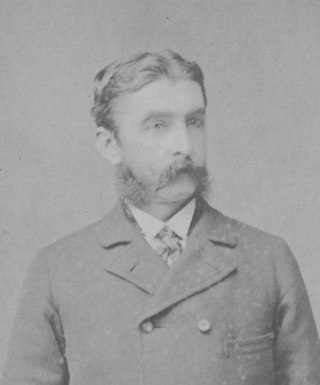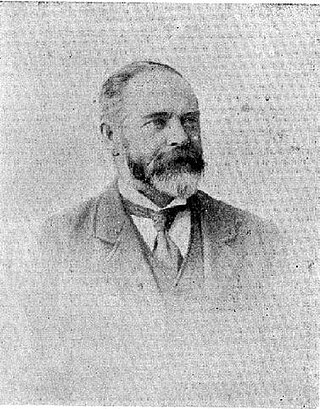Related Research Articles

The 1902 New Zealand general election was held on Tuesday, 25 November, in the general electorates, and on Monday, 22 December in the Māori electorates to elect a total of 80 MPs to the 15th session of the New Zealand Parliament. A total number of 415,789 (76.7%) voters turned out to vote.
The following lists events that happened during 1906 in New Zealand.

Sir Thomas Mason Wilford was a New Zealand politician. He held the seats of Wellington Suburbs then Hutt continuously for thirty years, from 1899 to 1929. Wilford was leader of the New Zealand Liberal Party, and Leader of the Opposition from 1920 to 1925.
Algernon Gray Tollemache was a British gentleman and politician. He was the sixth and youngest son of William Tollemache, Lord Huntingtower and Catherine Gray.

Napier is a New Zealand parliamentary electorate, returning one Member of Parliament to the House of Representatives. It is named after the city of Napier, the main urban area within the electorate. The electorate was established for the 1861 election and has existed since. It has been held by Katie Nimon of the New Zealand National Party since the 2023 general election. It was held by Stuart Nash of the New Zealand Labour Party from the 2014 general election until 2023, when he did not stand for re-election.

Wairarapa is a New Zealand parliamentary electorate. It was first created in 1858 and existed until 1881. It was recreated in 1887 and has since existed continuously. The current Wairarapa electorate MP is Mike Butterick.

Sir Donald McLean was a 19th-century New Zealand politician and government official. He was involved in negotiations between the settler government and Māori from 1844 to 1861, eventually as Native Secretary and Land Purchase commissioner. He was one of the most influential figures in Māori-Pākehā relations in the mid-1800s and was involved in the dispute over the "Waitara Purchase", which led up to the First Taranaki War.
Ruahine is a former New Zealand parliamentary electorate, from 1972 to 1978.

John Vigor Brown, known as Vigor Brown, was a New Zealand Member of Parliament for Napier, in the North Island. He was Mayor of Napier for a total of 18 years. He was a well-known figure in his adopted city, a successful businessman, and involved in many clubs and organisations.
Wellington, was a parliamentary electorate in Wellington, New Zealand. It existed from 1853 to 1905 with a break in the 1880s. It was a multi-member electorate. The electorate was represented, over the years, by 24 members of parliament.

Sir Robert Donald Douglas Maclean, generally known as Douglas Maclean but earlier spelled McLean like his father, was one of the largest land holders in the Hawke's Bay region of New Zealand. He was regarded as the country's most successful breeder of shorthorn cattle and Welsh Ponies. He had inherited his station from his father, Donald McLean, who was one of the most influential figures in Māori-Pākehā relations in the mid-1800s. For one term, Douglas Maclean represented the Napier electorate as an independent Conservative member of parliament. After his death, his station was broken up and the land is now covered by 60 farms. The woolshed of his station still exists. It is registered as a Category I heritage structure by Heritage New Zealand.

Walter Hippolyte Pilliet JP was a 19th-century Member of Parliament in Christchurch, New Zealand. He worked initially as a surveyor and was then resident magistrate in several places. He was a newspaper editor and was represented in Parliament for one term.

William McLean was a 19th-century Liberal Party Member of Parliament in Wellington, New Zealand.

Thomas Shailer Weston, often referred to as Thomas S. Weston, was a judge and 19th-century Member of Parliament from Westland, New Zealand. Weston was the patriarch of one of two dominant Canterbury families of the legal profession.
Frederick Sutton was a 19th-century Member of Parliament from the Hawke's Bay Region of New Zealand and an early settler, storekeeper and farmer in the area.
The Mayor of Napier is the head of the municipal government of Napier, New Zealand, and presides over the Napier City Council. Napier is New Zealand's ninth largest city. The first mayor was elected in 1875. The current mayor is Kirsten Wise.

William Wilson McCardle JP was a member of the New Zealand Legislative Council. Born in Scotland, he came to New Zealand as a young man and lived in a variety of places. He was a nurseryman and advocated for land reform. He established the town of Pahiatua and it was in the Wairarapa district that his local government involvement was most influential. He stood in a number of general elections for Parliament, but was never successful. A committed liberal politician, he was appointed to the Legislative Council by the first Ward Ministry in 1907 and served for one term until 1914.
The Patea by-election was a by-election in the New Zealand electorate of Patea, a rural seat on the west coast of the North Island.

The Mayor of Lyttelton was the head of the municipal government of Lyttelton, New Zealand. The position existed from 1868, when the Borough of Lyttelton was formed.
The Social Credit-NZ party was a political party in New Zealand which split from the New Zealand Democratic Party in 1988.
References
- 1 2 Wilson, James Oakley (1985) [First published in 1913]. New Zealand Parliamentary Record, 1840–1984 (4th ed.). Wellington: V.R. Ward, Govt. Printer. p. 237. OCLC 154283103.
- ↑ Ward, Alan. "McLean, Donald". Dictionary of New Zealand Biography . Ministry for Culture and Heritage . Retrieved 21 January 2019.
- 1 2 "Napier Election". Hawke's Bay Herald . Vol. XX, no. 3885. 22 February 1877. p. 2. Retrieved 21 January 2019.
- ↑ Platts, Una (1980). "Beetham, Richmond 1836–1912". Nineteenth Century New Zealand Artists: A Guide & Handbook. Christchurch: Avon Fine Prints. p. 39. Retrieved 20 January 2019.
- ↑ "Napier Election". Waka Maori. 27 February 1877.